This application note introduces the use of RT-Thread NetUtils, and helps developers to better use RT-Thread NetUtils components to solve problems encountered during network development.
The purpose and background of this article
When developing and debugging network-related products, some useful gadgets can often get twice the result with half the effort. Based on this application scenario, the RT-Thread NetUtils component develops and encapsulates a series of simple and easy-to-use network tools to provide convenience for developers.
In order to facilitate users to develop network applications, RT-Thread makes NetUtils component packages with commonly used network tools, and dynamically configures them through env, which can be used immediately, effectively reducing resource consumption.
Structure of this article
NetUtils component introduction
Ping tool configuration and use
Configuration and use of NTP time synchronization tool
Use of TFTP file transfer tool
Configuration and use of Iperf network bandwidth test tool
Configuration and use of other network debugging tools
Problem statement
This application note will introduce the RT-Thread NetUtils component around the following questions.
What does RT-Thread NetUtils mainly include? What are their functions?
How to use Ping tool to diagnose network stability?
How to test network stability and bandwidth?
How to transfer files over the network?
Problem solving
NetUtils component introduction
RT-Thread NetUtils is a collection of network tools, including Ping commands for testing and debugging, NTP tools for synchronizing time, Iperf and NetIO for performance and bandwidth testing, and TFTP, a lightweight file transfer tool widely used in embedded systems , Conveniently complete the file transfer between the two devices through the network. In addition, RT-Thread also provides some advanced auxiliary tools for actual problems in development, such as the Telnet tool that can remotely log in to RT-Thread Finsh/MSH Shell, and the network packet capture tool tcpdump based on lwIP.
The following is the classification and introduction of RT-Thread NetUtils:
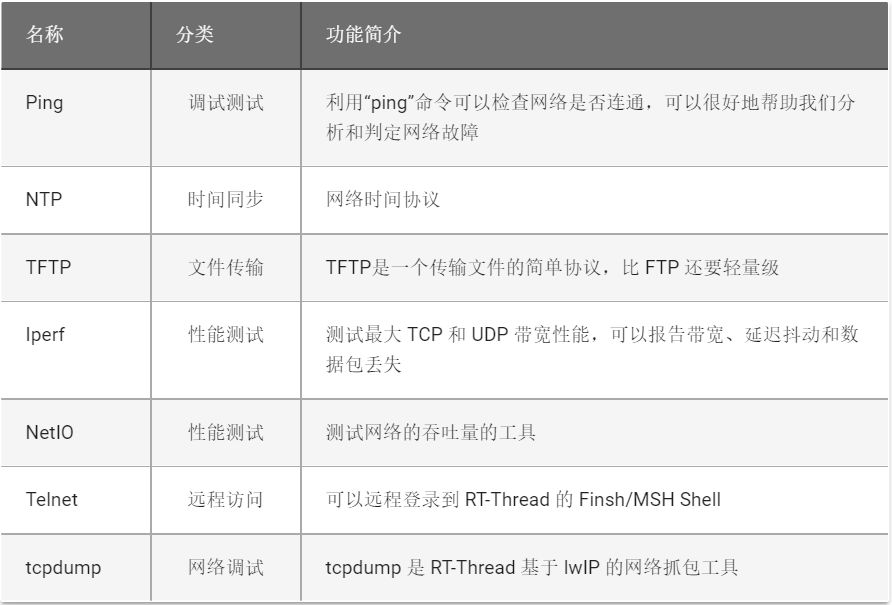
Each gadget can be enabled/disabled independently using menuconfig and provides commands for using Finsh/MSH. First open the env tool, enter the BSP directory, enter menuconfig on the env command line to enter the configuration interface configuration project, select the appropriate NetUtils function according to your needs, as shown in the figure (Note: Ping and TFTP depend on lwIP, you need to open the dependency of lwIP first To display)
RT-Thread online packages -> IoT-internet of things -> netutils: Networking utilities for RT-Thread
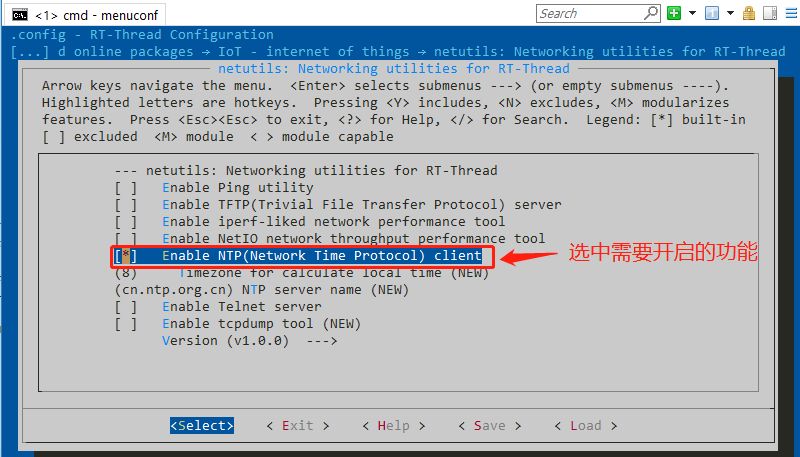
Ping tool configuration and use
Introduction
Ping is a network diagnostic tool used to test whether data packets can reach a specific host through the IP protocol. Estimate the packet loss rate (packet loss rate) and round-trip time (network delay, Round-trip delay time) between the host and the host
use
The Ping tool depends on lwIP. You need to enable the dependency of lwIP in the env tool to be visible. The steps are as follows:
-> RT-Thread Components -> Network stack -> light weight TCP/IP stack -> Enable lwIP stack
Enable the Ping option in the NetUtils menu bar:
RT-Thread online packages -> IoT-internet of things -> netutils: Networking utilities for RT-Thread [*] Enable Ping utility
Ping supports access to IP addresses or domain names. Use Finsh/MSH commands for testing. The general results are as follows:
Ping domain name
msh />ping rt-thread.org 60 bytes from 116.62.244.242 icmp_seq=0 ttl=49 time=11 ticks 60 bytes from 116.62.244.242 icmp_seq=1 ttl=49 time=10 ticks 60 bytes from 116.62.244.242 icmp_seq=2 ttl=49 time=12 ticks 60 bytes from 116.62.244.242 icmp_seq=3 ttl=49 time=10 ticks msh />
Ping IP
msh />ping 192.168.10.12 60 bytes from 192.168.10.12 icmp_seq=0 ttl=64 time=5 ticks 60 bytes from 192.168.10.12 icmp_seq=1 ttl=64 time=1 ticks 60 bytes from 192.168.10.12 icmp_seq=2 ttl= 64 time=2 ticks 60 bytes from 192.168.10.12 icmp_seq=3 ttl=64 time=3 ticks msh />
Configuration and use of NTP tools
Introduction
NTP is the Network Time Protocol (Network Time Protocol), which is a protocol used to synchronize the time of each computer in the network. An NTP client is implemented on RT-Thread. After connecting to the network, the current UTC time can be obtained and updated to RTC.
use
Enable the NTP option in the NetUtils menu bar:
RT-Thread online packages -> IoT-internet of things -> netutils: Networking utilities for RT-Thread [*] Enable NTP(Network Time Protocol) client
Get UTC time UTC time is also known as Universal Time, Universal Standard Time, and International Coordinated Time. Beijing time is UTC+8 time, which is 8 hours longer than UTC time, or understood as 8 hours earlier.
API: time_t time_t ntp_get_time(void)
Parameter Description| no | no |
| return | description |
| >0 | Current UTC time |
| =0 | Failed to get time |
Sample code:
#include void main(void) {time_t cur_time; cur_time = ntp_get_time(); if (cur_time) {rt_kprintf("NTP Server Time: %s", ctime((const time_t*) &cur_time));}}
Get local time
Local time has more time zone concept than UTC time. For example, Beijing time is Dongba District, which is 8 hours longer than UTC time.
The current time zone can be set in menuconfig, the default is 8
API:time_t ntp_get_local_time(void)

The API usage method is similar to ntp_get_time()
Synchronize local time to RTC
If the RTC device is turned on, you can also use the following commands and API to synchronize the local time of NTP to the RTC device.
The effects of Finsh/MSH commands are as follows:
msh />ntp_sync Get local time from NTP server: Sat Feb 10 15:22:33 2018 The system time is updated. Timezone is 8. msh />
API: time_t ntp_sync_to_rtc(void)

Note 1. The NTP API method will take up a lot of thread stacks during execution. Ensure that the stack space is sufficient (≥1.5K) when using it; 2. The NTP API method does not support reentrant. Please pay attention to locking when used concurrently.
TFTP tool configuration and use
Introduction
TFTP (Trivial File Transfer Protocol, Trivial File Transfer Protocol) is a protocol used for simple file transfer between client and server in the TCP/IP protocol suite. It provides uncomplicated and inexpensive file transfer services. The number is 69, which is much lighter than the traditional FTP protocol and is suitable for small embedded products.
RT-Thread currently supports TFTP server.
use
The TFTP tool depends on lwIP, you need to enable the dependency of lwIP in the env tool to be visible, the steps are as follows:
-> RT-Thread Components -> Network stack -> light weight TCP/IP stack -> Enable lwIP stack
Enable the TFTP option in the NetUtils menu bar:
RT-Thread online packages -> IoT-internet of things -> netutils: Networking utilities for RT-Thread [*] Enable TFTP(Trivial File Transfer Protocol) server
Install TFTP client
The installation file is located at netutils/tools/Tftpd64-4.60-setup.exe, please install the software before using TFTP.
Start the TFTP server
Before transferring files, you need to use the Finsh/MSH command on RT-Thread to start the TFTP server. The general effect is as follows:
msh />tftp_server TFTP server start successfully. msh />
Transfer files
Open the Tftpd64 software you just installed and configure it as follows:
1. Select Tftp Client; 2. In the Server interfaces drop-down box, be sure to select the network card in the same network segment as RT-Thread; 3. Fill in the IP address of the TFTP server. You can use the ifconfig command to view under the MSH of RT-Thread; 4. Fill in the TFTP server port number, default: 69
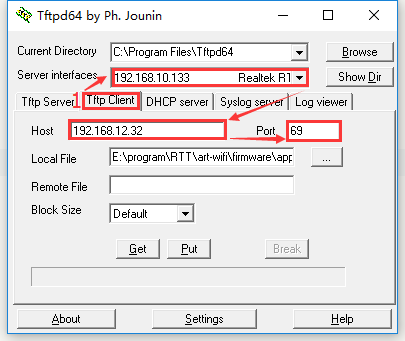
Send files to RT-Thread
1. In the Tftpd64 software, select the file to be sent; 2. Remote File is the path (including file name) where the file is saved on the server side. The options support relative and absolute paths. Since RT-Thread turns on the DFS_USING_WORKDIR option by default, the relative path is based on the directory currently entered by Finsh/MSH. Therefore, when using a relative path, be sure to switch the directory in advance; 3. Click the Put button.
As shown in the figure below, send the file to the directory currently entered by Finsh/MSH, where the relative path is used:

Note: If DFS_USING_WORKDIR is not turned on and the Remote File is empty, the file will be saved to the root path.
Receive files from RT-Thread
1. In the Tftpd64 software, fill in the path of the file to be saved (including the file name); 2. Remote File is the path of the file to be received back from the server (including the file name), and the options support relative and absolute paths. Since RT-Thread turns on the DFS_USING_WORKDIR option by default, the relative path is based on the directory currently entered by Finsh/MSH. Therefore, when using a relative path, be sure to switch the directory in advance; 3. Click the Get button.
As shown below, save /web_root/image.jpg to the local, where the absolute path is used:
msh /web_root>ls ##Check whether the file exists Directory /web_root: image.jpg 10559 msh /web_root>
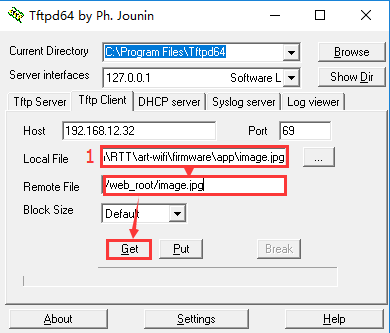
Configuration and use of Iperf tool
Introduction
Iperf is a network performance testing tool. Iperf can test the maximum TCP and UDP bandwidth performance, has a variety of parameters and UDP characteristics, can be adjusted as needed, and can report bandwidth, delay jitter, and packet loss.
use
Enable the Iperf option in the NetUtils menu bar:
RT-Thread online packages -> IoT-internet of things -> netutils: Networking utilities for RT-Thread [*] Enable iperf-liked network performance tool
Iperf uses a master-slave architecture, that is, one end is the server and the other end is the client. The Iperf software package we provide implements the TCP server mode and the client mode, and does not support UDP testing for the time being. The following will explain how to use the two modes in detail.
Iperf server mode
Get IP address
You need to use the Finsh/MSH command on RT-Thread to obtain the IP address. The general effect is as follows:
msh />ifconfig network interface: e0 (Default) MTU: 1500 MAC: 00 04 9f 05 44 e5 FLAGS: UP LINK_UP ETHARP ip address: 192.168.12.71 gw address: 192.168.10.1 net mask: 255.255.0.0 dns server #0: 192.168.10.1 dns server #1: 223.5.5.5
Write down the obtained IP address 192.168.12.71 (record according to the actual situation)
Start the Iperf server
You need to use the Finsh/MSH command on RT-Thread to start the Iperf server. The general effect is as follows:
msh />iperf -s -p 5001
-s means to start as a server -p means to listen on port 5001
Install JPerf test software
The installation file is located in netutils/tools/jperf.rar. This is a green software. The installation is actually a process of decompression, just decompress it to a new folder.
Run jperf test
Open the jperf.bat software and configure as follows:
1. Select Client mode; 2. Enter the IP address 192.168.12.71 just obtained (fill in according to the actual address); 3. Modify the port number to 5001; 4. Click run Lperf! to start the test; 5. Wait for the end of the test. During the test, the test data will be displayed on the shell interface and the JPerf software.
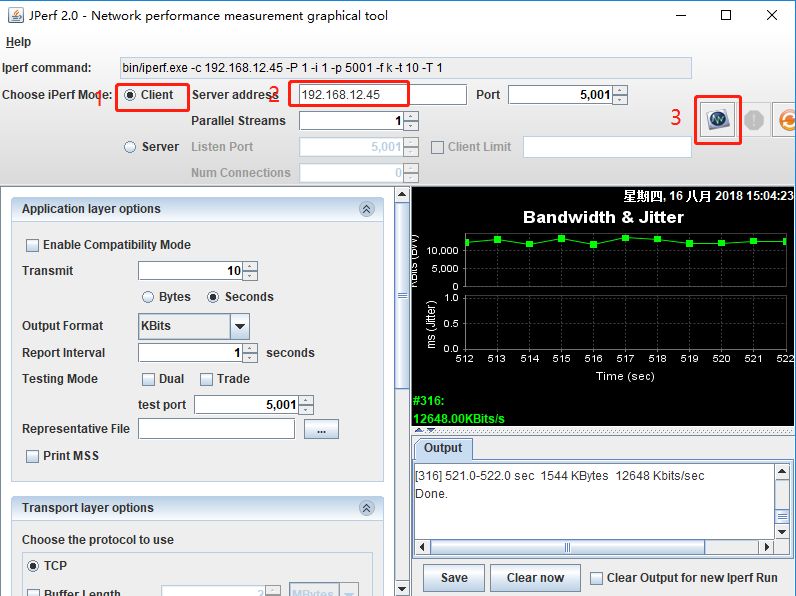
Iperf client mode
Get the IP address of the PC
Use the ipconfig command on the command prompt window of the PC to obtain the IP address of the PC, and note that the obtained PC IP address is 192.168.12.45 (recorded according to the actual situation).
Install JPerf test software
The installation file is located in netutils/tools/jperf.rar. This is a green software. The installation is actually a process of decompression, just decompress it to a new folder.
Open jperf server
Open the jperf.bat software and configure as follows:
1. Select Server mode 2. Modify the port number to 50013, click run Lperf! to start the server
Start the Iperf client
You need to use the Finsh/MSH command on RT-Thread to start the Iperf client. The general effect is as follows:
msh />iperf -c 192.168.12.45 -p 5001
-c means to start as a client, and then need to add the IP address of the pc running the server. -p means to connect to port 5001 and wait for the end of the test. During the test, the test data will be displayed on the shell interface and the JPerf software.
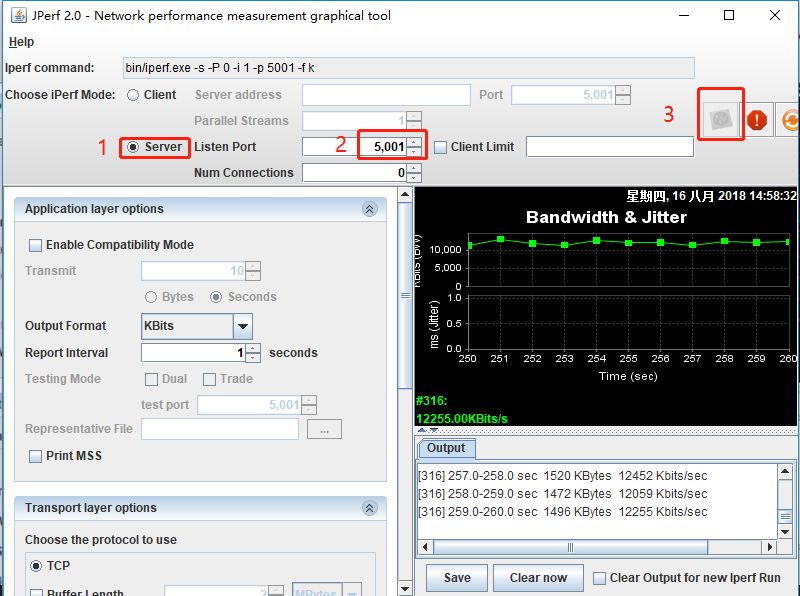
Introduction and use of other network debugging tools
In addition to the above-mentioned commonly used network tools, RT-Thread also provides some practical network tools in development and debugging, such as NetIO tools, Telnet tools and tcpdump tools.
NetIO tools
NetIO is a tool for network performance testing on OS/2 2.x, Windows, Linux and Unix. It uses TCP/UDP to test the net throughput of the network using data packets of different sizes.
RT-Thread currently supports NetIO TCP server.
For the use of NetIO, please refer to the README in the component catalog, and I won’t repeat it here.
Telnet tool
The Telnet protocol is an application layer protocol, used in the Internet and local area networks, in the form of a virtual terminal, providing two-way, text string-based interactive functions. It belongs to one of the TCP/IP protocol family. It is the standard protocol and main method of Internet remote login service. It is often used for remote control of web servers and allows users to run work on the remote host on the local host.
RT-Thread currently supports Telnet server. After the Telnet client is successfully connected, it will remotely connect to the Finsh/MSH of the device to realize remote control of the device.
For the use of Telnet, please refer to the README in the component catalog, which will not be repeated here.
tcpdump tool
tcpdump is a small tool for capturing IP packets based on RT-Thread. The captured data can be saved through the file system, or imported into the PC through the rdb tool, and analyzed by the wireshark software.
For the use of tcpdump, please refer to the README in the component directory, and I won’t repeat it here.
TPU Cutting Machine Accessories
Cutting Head Parts suitable for Screen Protector Cutting Machine.
The Cutting Blade can be used to cut Hydrogel Screen Protector, Back Film, Watch Screen Protector, etc. The quality of the Accessories For Cutter is higher than that of stainless steel, sharp and durable, and can be cut for a long time. In addition, the blade is protected by a plastic cover to avoid scratching your fingers.
Cutting Blade Parts For Screen Protector Cutter,Cutting Tip For Screen Protector Cutting Machine,Mobile Phone Screen Protection Cardboard Scraper Tool,Scraper For Film Cutting Machine
Shenzhen TUOLI Electronic Technology Co., Ltd. , https://www.hydrogelprotectors.com
